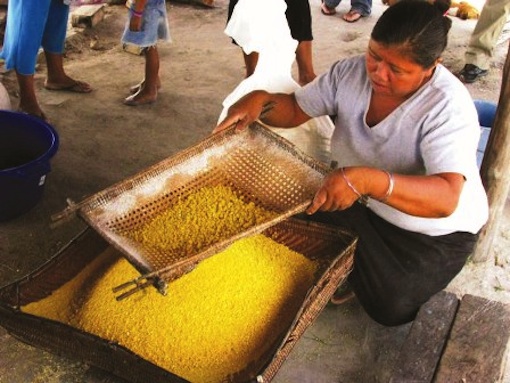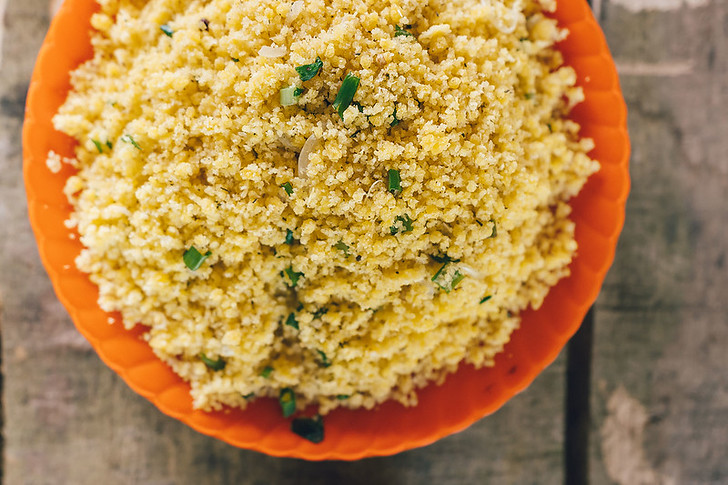Farine, is a coarse gravel-like flour, which is the remains of the sifted cassava flour. This is usually made and eaten by the Amerindians but has spread throughout Guyana. The Amerindians also use tasso which is made from sun-dried beef. When tasso is boiled with farine, it makes an edible and tasty dish for the Rupununi Ranchers and many others.
About Farine
Farine, a versatile commodity, is a traditional Amerindian staple made from cassava roots. It is used by the indigenous Amerindians of Guyana, particularly those in the Rupununi Savannahs, Region Nine. The origin seems to point to the Indigenous tribes that migrated from Brazil (e.g. Wapishana). Hence, the word farine is from the Portuguese word “farinha” which means “flour”. The Rupununi is known for its roasted meats, fried tasso, boiley and tuma pot. None of these dishes are complete without this traditional staple, farine.
How Farine Is Made

Farine Making | https://www.caribjournal.com
First, the cassava’s skin is sliced away and its meat is grated as finely as possible. The grated pulp is then enclosed in a porous bag and squeezed hard to release and strain the juice and moisture. The remaining pulp is then gently parched in a heated flat pan until it turns a light brown color, ideally over an open flame. This can literally take hours. The finished product – farine – resembles coarse grains, something like a heartier version of Cream of Wheat. In some areas of the Caribbean, the pulp is placed in the sun to dry for a few hours before being further parched over heat.
Cassava Farine
Ingredients:
- 2lbs cassava, grated finely
- 2tsp salt
Method:
- Peel and grate the cassava.
- Place in a cloth and squeeze out the water.
- Rub between your hands to make fine crumbs. Add the salt and mix.
- Spread a cloth and place the cassava to dry in the hot sun for at least 3 hours.
- Parch over a low fire stirring continuously until golden. Allow to cool.
- Store in an airtight container in a cool dry place.
Tip: Overall, it’s not a quick process, but when farine is stored in an airtight container in a cool, dark place, it will last almost forever.
How Farine Is Eaten
Farine is what remains after the juice has been removed from a cassava. By itself, it’s not much to get excited about. It’s dry and it borders on tasteless, but it has its uses. It has sustained generations of islanders during lean economic times. The cassava grows abundantly in most Caribbean areas; farine is filling, and it can be safely stored for long periods of time. Farine has an acquired taste – mostly because it doesn’t have much taste. It can be mixed with milk and sugar to liven it up, creating a nutritious drink, but it’s most often used as an ingredient in porridge and bread. It’s also added to soups and stews as a thickening agent, such as when making cassava cassareep.
Other Ways To Eat Farine
Farine Stuffing
Ingredients:
- 8 oz soaked farine
- 3 tsp oil for frying
- 2 oz chicken giblets or ham
- 1 tbsp finely chopped eschalot
- 1 tbsp finely chopped celery
- 1 egg to bind
Method:
- Heat oil. Fry seasoning and meat for 2 minutes.
- Add to soaked farine. Mix well and add salt to taste.
- Beat egg and use to bind the mixture.
- This stuffing can be used for stuffing meat such as chicken and fish.
Farine White Pudding
Ingredients:
- 2 lb farine
- 3 coconuts, grated
- 5 pt water to make coconut milk
- 8 oz salt beef
- 4 tbsp chopped thyme
- 2 tbsp chopped eschalot
- 2 tbsp chopped celery
- 4 yards runners (cow or pig offal)
- 2 tbsp oil
Method:
- Make coconut milk with the grated coconut and water. Soak farine in 2 pints of the coconut milk. Allow to swell.
- Cut salt beef in small pieces and fry with thyme, eschalot, celery and salt to taste.
- Add meat to farine.
- Fill runners with mixture using a funnel. Tie ends and boil in the remaining 3 pints of coconut milk. Boil for about 10 minutes.
- Prick for air to escape.
- Cool and brush with oil. Slice into desired size.
Note: For white pudding only coconut milk is used, no blood is added. You can also make farine fish fritters, farine black cake, farine coconut rock buns, just to name a few.
Farine In Guyana
Even though this hearty staple was introduced by the Amerindians, it is eaten by all the other cultures and races in Guyana. It adds flavor and variety to the diversity of the people. If you decide to make it, the process is a bit long so if you don’t have the time, you can look for it in the supermarkets or it is sold in the interior of Guyana. Farine can be eaten in a lot of ways, when you get it, you can try it out and find out which is your favorite way to eat it.
Article References:
- http://guyanachronicle.com/2017/10/01/farine-fiesta
- https://www.thespruceeats.com/what-is-farine-2137937
- http://www.guyanesefood.com/farine-dishes
- https://www.simplytrinicooking.com/cassava-farine/
- Main Image: https://shershegoes.com/guyanese-food/







